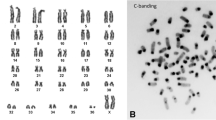Abstract
In PCR-supported amplification of ancient, degraded DNA, contamination with contemporary DNA can lead to false-positive results, which frequently give rise to discussions in which the mere existence of ancient DNA is doubted. Our confirmation of ancient DNA using comparative genome hybridization (CGH) eliminates these doubts. Unlike PCR methods, CGH requires no amplification of the DNA to be analyzed if adequate amounts of specimen DNA is used. Thus, false results traceable to contaminations are practically ruled out. The examples provided here prove the authenticity of ancient DNA for a 250-year-old and a 3000-year-old sample. At the same time, the CGH of ancient DNA offers the chance to gain insight into the pattern of DNA degradation and to monitor the preservation of certain chromosomal segments.
Similar content being viewed by others
Author information
Authors and Affiliations
Additional information
Received: 10 May 1999 / Accepted in revised form: 29 July 1999
Rights and permissions
About this article
Cite this article
Hummel, S., Herrmann, B., Rameckers, J. et al. Proving the Authenticity of Ancient DNA by Comparative Genomic Hybridization. Naturwissenschaften 86, 500–503 (1999). https://doi.org/10.1007/s001140050663
Issue Date:
DOI: https://doi.org/10.1007/s001140050663




